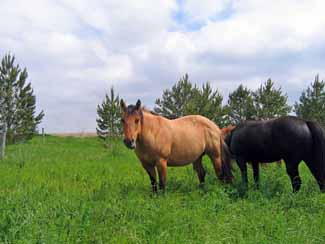Horse pasture and fructan concentrations
High fructan concentrations in horse pastures can be a potential precursor to laminitis in susceptible equine.
Much attention is now being paid to the type of carbohydrates present in forage since more horses are being diagnosed as insulin-resistant. In particular, easy keeping light horse breeds like Morgans, Paso Finos and Tennessee Walker, mustangs, ponies, and miniature donkeys, are targets for this condition, especially if they are allowed to be obese. Ingestion of water-soluble carbohydrates (glucose, fructose, sucrose, and fructan) found in rich spring grasses may trigger laminitis in some horses as a result of the rapid fermentation of the sugars in the hind gut (similar to a high-starch diet). While fructan content in hay and pastures is currently receiving the most attention since it is a potential trigger for laminitis in susceptible horses, all sugars and starches should be considered potential triggers.
Fructan concentrations can vary greatly according to the growing season, weather conditions, and time of day. Fructans are found in the largest quantities in cool season grasses. Early spring pastures are highest in sugar content with mid-summer pastures being lowest and early fall/autumn pastures being intermediate in sugar content. In addition, as a result of photosynthesis reaction, sugars begin to accumulate in grasses during the early morning and reach their peak by the afternoon. They steadily decline as the sunlight intensity decreases and reach their lowest values during the night. Fructans increase in grasses during drought conditions as the plant tries to resist the stress of low water.
For horses that have chronic laminitis, it is important to limit their grazing during peak periods of sugar content in pastures. Hay should also be selected based on sugar content for these horses.
Definitions:
Insulin-resistant: When cells do not respond appropriately to insulin in the body. Insulin transports glucose from blood to muscle and tissues. An accurate diagnosis of insulin-resistance requires an examination and a glucose tolerance test by a veterinarian.
Laminitis: A metabolic disorder commonly referred to as founder, can affect all four feet, but is most common in the front feet. Laminitis causes the sensitive and insensitive lamina of the hoof wall to become inflamed, leading to separation.

Lush spring pastures can be high in fructan content.
For more information read the following MSUE News articles:
- Managing horses on spring pastures
- Pastures provide a valuable feed source for horses
- Spring pastures put some horses at health risk
Additional Resources Related to the Topic:
My Horse University and eXtension Free Archived Webcasts:
- Equine Metabolic Syndrome
Dr. Raymond Geor Recorded October 2010 - Countermeasures for Equine Laminitis: Carbohydrate Profiles in Feeds and Forages
Dr. Bridgett McIntosh, Recorded: April 2009 - Pasture Management for Horse Acreages
Dr. Dave Freeman, Recorded: February 2009
eXtension/horse Learning Lessons:
This article is an excerpt from My Horse University Online Horse Nutrition Course. Other resources offered by My Horse University and eXtension HorseQuest include a free monthly e-newsletter, free monthly webcasts and social networks on Facebook , Twitter, and YouTube.



 Print
Print Email
Email


